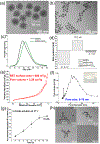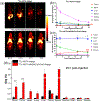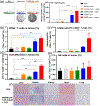Positron Emission Tomography-Guided Photodynamic Therapy with Biodegradable Mesoporous Silica Nanoparticles for Personalized Cancer Immunotherapy
- PMID: 31556987
- PMCID: PMC6832743
- DOI: 10.1021/acsnano.9b06691
Positron Emission Tomography-Guided Photodynamic Therapy with Biodegradable Mesoporous Silica Nanoparticles for Personalized Cancer Immunotherapy
Abstract
Photodynamic therapy (PDT) is an effective, noninvasive therapeutic modality against local tumors that are accessible to the source of light. However, it remains challenging to apply PDT for the treatment of disseminated, metastatic cancer. On the other hand, cancer immunotherapy offers a promising approach for generating systemic antitumor immune responses against disseminated cancer. Here we report a multifunctional nanomaterial system for the combination of PDT and personalized cancer immunotherapy and demonstrate their potency against local as well as disseminated tumors. Specifically, we have synthesized uniform and biodegradable mesoporous silica nanoparticles (bMSN) with an average size of ∼80 nm and large pore size of 5-10 nm for theranostic positron emission tomography (PET)-guided PDT and neoantigen-based cancer vaccination. Multiple neoantigen peptides, CpG oligodeoxynucleotide adjuvant, and photosensitizer chlorin e6 were coloaded into a bMSN nanoplatform, and PET imaging revealed effective accumulation of bMSN in tumors (up to 9.0% ID/g) after intravenous administration. Subsequent PDT with laser irradiation recruited dendritic cells to PDT-treated tumor sites and elicited neoantigen-specific, tumor-infiltrating cytotoxic T-cell lymphocytes. Using multiple murine models of bilateral tumors, we demonstrate strong antitumor efficacy of PDT-immunotherapy against locally treated tumors as well as distant, untreated tumors. Our findings suggest that the bMSN is a promising platform for combining imaging and PDT-enhanced personalized immunotherapy for the treatment of advanced cancer.
Keywords: cancer immunotherapy; mesoporous silica nanoparticles; neoantigen; photodynamic therapy; positron emission tomography; vaccine.
Conflict of interest statement
The authors declare no competing financial interest.
Figures








Similar articles
-
Near-Infrared-Triggered Photodynamic Therapy with Multitasking Upconversion Nanoparticles in Combination with Checkpoint Blockade for Immunotherapy of Colorectal Cancer.ACS Nano. 2017 May 23;11(5):4463-4474. doi: 10.1021/acsnano.7b00715. Epub 2017 Apr 21. ACS Nano. 2017. PMID: 28362496
-
Multifunctional mesoporous silica nanoplatform based on silicon nanoparticles for targeted two-photon-excited fluorescence imaging-guided chemo/photodynamic synergetic therapy in vitro.Talanta. 2020 Mar 1;209:120552. doi: 10.1016/j.talanta.2019.120552. Epub 2019 Nov 13. Talanta. 2020. PMID: 31892096
-
Red-light-triggered self-destructive mesoporous silica nanoparticles for cascade-amplifying chemo-photodynamic therapy favoring antitumor immune responses.Biomaterials. 2022 Feb;281:121368. doi: 10.1016/j.biomaterials.2022.121368. Epub 2022 Jan 10. Biomaterials. 2022. PMID: 35030436
-
Radiolabeling Silica-Based Nanoparticles via Coordination Chemistry: Basic Principles, Strategies, and Applications.Acc Chem Res. 2018 Mar 20;51(3):778-788. doi: 10.1021/acs.accounts.7b00635. Epub 2018 Feb 28. Acc Chem Res. 2018. PMID: 29489335 Free PMC article. Review.
-
Mesoporous Silica as a Versatile Platform for Cancer Immunotherapy.Adv Mater. 2019 Aug;31(34):e1803953. doi: 10.1002/adma.201803953. Epub 2018 Nov 12. Adv Mater. 2019. PMID: 30417454 Review.
Cited by
-
Polydopamine-Mesoporous Silica Core-Shell Nanoparticles for Combined Photothermal Immunotherapy.ACS Appl Mater Interfaces. 2020 Sep 23;12(38):42499-42510. doi: 10.1021/acsami.0c10781. Epub 2020 Sep 8. ACS Appl Mater Interfaces. 2020. PMID: 32838525 Free PMC article.
-
Nanomaterials: A powerful tool for tumor immunotherapy.Front Immunol. 2022 Aug 22;13:979469. doi: 10.3389/fimmu.2022.979469. eCollection 2022. Front Immunol. 2022. PMID: 36072591 Free PMC article. Review.
-
Improving STING Agonist Delivery for Cancer Immunotherapy Using Biodegradable Mesoporous Silica Nanoparticles.Adv Ther (Weinh). 2020 Oct;3(10):2000130. doi: 10.1002/adtp.202000130. Epub 2020 Jul 21. Adv Ther (Weinh). 2020. PMID: 34295963 Free PMC article.
-
Light-triggered multifunctional nanoplatform for efficient cancer photo-immunotherapy.J Nanobiotechnology. 2022 Apr 7;20(1):181. doi: 10.1186/s12951-022-01388-8. J Nanobiotechnology. 2022. PMID: 35392911 Free PMC article.
-
Ultrasound-responsive low-dose doxorubicin liposomes trigger mitochondrial DNA release and activate cGAS-STING-mediated antitumour immunity.Nat Commun. 2023 Jun 30;14(1):3877. doi: 10.1038/s41467-023-39607-x. Nat Commun. 2023. PMID: 37391428 Free PMC article.
References
-
- Lucky SS; Soo KC; Zhang Y Nanoparticles in Photodynamic Therapy. Chem. Rev 2015, 115, 1990–2042. - PubMed
-
- Wang C; Tao H; Cheng L; Liu Z Near-Infrared Light Induced In Vivo Photodynamic Therapy of Cancer Based on Upconversion Nanoparticles. Biomaterials 2011, 32, 6145–6154. - PubMed
-
- Yuan Y; Zhang CJ; Gao M; Zhang R; Tang BZ; Liu B Specific Light-Up Bioprobe with Aggregation-Induced Emission and Activatable Photoactivity for the Targeted and Image-Guided Photodynamic Ablation of Cancer Cells. Angew. Chem., Int. Ed 2015, 54, 1780–1786. - PubMed
Publication types
MeSH terms
Substances
Grants and funding
LinkOut - more resources
Full Text Sources

